Mike Gundy's war on modern football
The Oklahoma State Cowboys have ostensibly been crushed by the portal but Gundy is quietly reordering the team to play the modern game. Can he succeed?
What’s going on with Oklahoma State?
It’s been quite the offseason for Mike Gundy’s Cowboys. Defensive coordinator Derek Mason decided to resign in order to take some time away from the college game with the recruiting and transfer portal grind. Quarterback Spencer Sanders, a four-year starter, decided to transfer away as well before deciding late in the process to come back to OSU only for Gundy to tell him the program had already decided to move on.
Sanders ended up heading to Ole Miss along with a blue chip redshirt freshman from LSU, raising some questions about Jaxson Dart’s job security.
Beyond Spencer Sanders, the Pokes have seen 17 players exit via the transfer portal, including the following names:
Starting Mike linebacker Mason Cobb (USC)
Rotational Edge Trace Ford (to Oklahoma no less!)
Starting running back Dom Richardson (Baylor)
Starting nickel Thomas Harper (Notre Dame)
Starting cornerback Jabbar Muhammad (Washington)
Rotational receiver John Paul Richardson (TCU)
Starting receiver Bryson Green (Wisconsin)
Emerging young star receiver Stephon Johnson (Houston)
So not just struggling back-ups looking for playing time but multiple players who had prominent roles on the team. OSU’s roster was absolutely pillaged.
Gundy patched all of these holes with the following key additions:
Division II defensive coach Bryan Nardo as defensive coordinator
Michigan back-up quarterback (formerly Texas Tech starter) Alan Bowman
Michigan State back-up running back Elijah Collins
Texas State offensive tackle Dalton Cooper
UNLV redshirt freshman O-lineman Noah McKinney
Tulsa’s defensive end and Mike linebacker Anthony Goodlow and Justin Wright
Washington State receiver De’Zhuan Stribling
Utah Tech nose tackle Justin Kirkland
Of the guys mentioned above, that’s six potentially new starters, mostly from lower levels, to say nothing of a new defensive coordinator pulled out of nowhere Pennsylvania and a new starting quarterback who hasn’t seen significant playing time since the 2020 season.
Quite the roster overhaul. Should we be shoveling dirt on the Mike Gundy Oklahoma State program?
Maybe, maybe not. Inherent in some of OSU’s changes are a number of evolutions the program is embracing to try and keep pace with the modern game. Restocking the roster with veterans from the lower levels is just a fraction of what OSU has been up to.
Bryan Nardo and Flyover defense
In my last column, I noted differences between the college game and NFL and the implication for how top D-line talents are utilized.
The job of college D-linemen is inglorious and largely run-centric. You don’t get a ton of chances to rush the passer against a true dropback by the quarterback where he’s trying to read the field behind a five or six-man protection. The opportunities for D-linemen to 1-on-1 matchups and the time to realistically pressure the quarterback are nowhere near as plentiful as in the NFL.
Recall the 2022-23 San Francisco 49ers who fielded pass-rushers across their 4-man D-line and weren’t punished for lacking a good nose tackle until they faced the Philadelphia Eagles in the NFC Championship game.
Fielding pass-rushers without anchors against the run is a non-starter in the college game. The percentage of quarterback passes in the college game that are RPOs, screens, or play-action shots off max protection (seven or eight blockers) is very high, even in spread offenses with multiple receivers aligned in space.
As we’ve discussed, the Flyover is designed with this in mind and positions the D-line to clog interior lanes with pass-rush as a secondary concern. Mike Gundy hired Nardo from DII obscurity specifically because of his familiarity with the Flyover scheme.
Last year OSU ran more of a hybrid 3-3-5 that at times was a 2-4-5 with a pair of Edges on the field. The defense boasted three good Edges on the roster, but then they lost Brock Martin to graduation and Trace Ford to rival Oklahoma leaving only the smaller but highly effective Collin Oliver (6-foot-2, 230 pounds) for 2023.
The challenge in converting to a Flyover was filling out the front with cloggers. So they added a D-lineman from Tulsa, who was running the Flyover scheme, and they found something really interesting in Utah Tech transfer Justin Kirkland.
Out of high school as a Utah kid, Kirkland intended to first do his two-year mission with the LDS Church and Utah Tech was the only school to guarantee a scholarship if he took the mission first. So he joined as a 20-year old freshman in 2022 and was an immediate starter. They listed him at 6-foot-4, 300 pounds but at OSU as a rising sophomore for spring he’s already listed at 346 and looks…big.
I’ve seen his film last year against a Big 12 caliber (officially) opponent in BYU and he’s not just a big body. The dude has some burst and can hold the point of attack against double teams. Cincinnati and Kansas State got in on him late as well but OSU held them off to secure the commitment.
Last year OSU had three good Edges and a defensive end/tackle hybrid liable to get drafted (Tyler Lacy) but they couldn’t stop the run, gave up 28.9 points per game, and sack numbers plummeted. Martin went from nine sacks in 2021 to 3.5 in 2022 and Oliver from 10.5 sacks to five. The trick with the 2-4-5 is your defensive tackles have to be legitimately good inside and OSU had lost nose tackle Israel Antwine and didn’t have another anchor to take on double teams on the roster.
Well, now they have this Kirkland kid and he’s got three years of eligibility left despite already being as old as an upperclassman. To revisit an earlier graphic I made about the struggle for smaller schools building up their trenches:
Checking off no. 2 is a big deal and potentially a much bigger deal for Oklahoma State than even the loss of several legitimately good wide receivers or defensive backs, which they’ve shown they can consistently find.
If they get Oliver comfortable working as a regularly blitzing linebacker in the Flyover scheme (likely) this looks like a formidable unit to me. Gundy’s stated preference is for development over the portal, but they seem to evaluate lower level prospects and incorporate them into the program quite well.
The power run game
Another interesting rumor of the offseason for Oklahoma State concerns their approach to rebuilding the run game.
For the last several seasons, despite having Spencer Sanders to boost the run game with his ability to run zone-option keepers or hit throws down the field, the Cowboys have really struggled to run the ball consistently.
In 2021 they got by thanks to the infusion of a Utah JUCO running back named Jaylen Warren they unearthed (Utah is becoming Gundy’s personal reserve for key transfers) and an offensive line basically comprised of five guards. Two of the linemen graduated, another was injured, and Warren was drafted by the Steelers leading the OSU run game to crater in 2022.
Here’s the apparent adjustment, a move away from the zone blocking they’ve relied on as long as I’ve followed Mike Gundy’s OSU. Along with that adjustment are some peripheral moves such as:


Everyone who’s a real contributor at their “ancillary” tight end position they’ve been calling the Cowboy back is now listed as a fullback. I can only assume this portends an embrace of fullback life, probably more so than any major adjustment in their alignment. True fullback life is kicking out defensive ends on the power play, traditional power or “duo.”
Those guys have already primarily been blockers, but they were almost always either leading on the edge, trapping the backside on zone plays, or arcing around the edge to lead for the quarterback. It’s a different world when you’re lined up across from an end and your job is to take him on, mano a mano, and either hold the point or drive him back. These guys are already full-time blockers though so it’s a reasonable adjustment.
Their line is also noticeably heavier on their spring roster. For years one of their big advantages has been the ability to beef up players over time with top notch strength coach Rob Glass, but they haven’t been all in on building just sheerly enormous lines because of their preference for outside zone blocking. If gap schemes are now a bigger part of the formula, then getting vertical movement is a priority which requires some leverage and power.
There’s one regard in which this move to power football is a boost to their offensive chances in the fall and another in which it’s a potential detriment.
The detriment is from the fact other defenses are trying to build their defenses in the same fashion as Oklahoma State. They’re also looking to clog interior lanes with big, powerful D-linemen in order to allow the linebackers and secondary to sit off the ball and avoid run/pass conflicts. This raises the bar for trying to make your run game strategy simply bulldozing opponents.
Here’s traditional power against a Flyover “back” front like TCU uses:
And here’s the spread version of “Duo” against a similar look:
Easy to see why this is becoming a more popular to run power/gap schemes, no? It’s more straightforward, although the angles aren’t always as good, because the line just mashes the people in front of them and the running back essentially makes them right.
The trick against these Flyover teams is the position labelled as “N” here since TCU calls their box/middle safety the nickel. The Frogs tend to be pretty aggressive with the Sam since their “Free” safety Bud Clark can man up the slot from depth, so you have to plan on blocking him which doesn’t leave anyone for the nickel or strong safety if they join the action.
The nickel in particular, what do you threaten him with? You can hold the other safeties back with RPOs, but he’s always fitting top down.
Also, if you can’t get good movement on the down linemen with your line? Man are you in trouble, the nickel will run free to the ball but only to help push a pile down near the line of scrimmage.
If you can include quarterback option elements, it helps, but these power schemes with a blocking fullback don’t depend on a mobile quarterback to work. That’s the good news, because the Cowboys will probably start Alan Bowman and if not, it’ll be Garrett Rangel. Both of these guys are kids who grew up slinging RPOs in Texas spread offenses but aren’t dangerous runners.
They do their best work paired with a vertical passing dimension and a blocking fullback who can absolve them of the need to get involved in evening out the box counts for the running game by carrying it themselves.
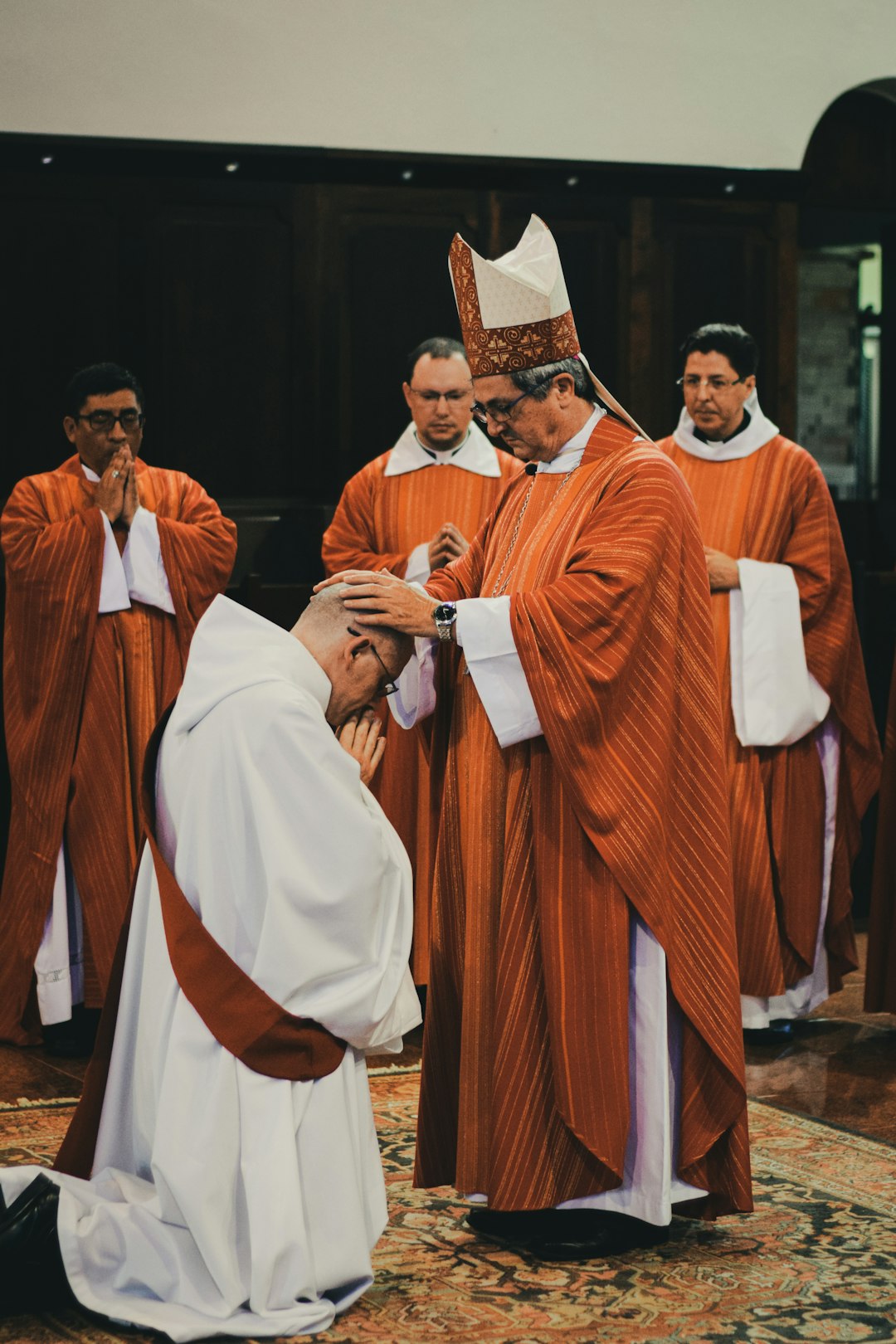
I’ve tended to label this style of offense, using a blocking fullback to run power schemes with RPOs from the three-wide sets the “smashmouth spread” offense. The goal is to spread you out but to pair power and numbers at the point of attack in the run game with passing options outside.
The Flyover defense is designed to mitigate all of the challenges presented by the smashmouth spread. So how will that go for Oklahoma State?
Mike Gundy’s last crusade
Gundy has at least one more ace up his serve, offensive line coach Charlie Dickey.
Gundy wanted to hire him for years but couldn’t pry him away from Bill Snyder and Kansas State until the old man was pushed out and his O-line coach was no longer tied to the job. After hiring Dickey for the job in 2019, OSU promptly continued to run almost exclusively zone blocking schemes.
Now Dickey knows those well, but his K-State teams ran a full gamut of blocking schemes with people pulling all over the place in multiple gap schemes in addition to running zone. After some initial rumors Gundy would hire a new O-line coach, it appears he’s staying with Dickey and the ‘Pokes will be diversifying their run game package.
As I note above, simply running power/counter/duo at the Flyover defense isn’t a slam dunk. You have to be really big and strong to lean on these teams and blow open holes their three-high safety format can’t fill. But there’s another way.
Here’s a few varieties of run schemes I’ve seen teams use against the Flyover to find angles.
By putting the back to the same side as the pullers and the tight end opposite, when TCU played the “back front” with an Edge set to the strong side Texas got a double team there and an easy block back on the other end in a 4i-technique.
Since all the receivers were on the “weak” side (run wise), TCU had a cornerback who was supposed to set the edge and found a guard pulling for him. This went poorly, the double team went well, and while the pulling tackle didn’t find anyone to block the play still went for an easy nine yards.
Here’s another example:


I’ll draw this one since the angle is kinda tough:
Basically they faced a front where they had an angle on a 4i defensive end, pinned him with the tackle, and pulled blockers around the perimeter. Arkansas would meet the pullers with the off-ball defenders and the angles weren’t great for the Razorbacks facing big blockers. Their Sam, who was a safety, had to set the edge against a pulling guard and the fullback had a good angle to find the Mike linebacker.
The slot Y receiver ran right up the middle of the field, which is VERY important to note, because it held both the free safety and the nickel back from fitting the run more aggressively since they were concerned they had coverage responsibility.
Here’s an old K-State spread scheme which could be similarly useful against the Flyover. The iso.
The open bubble where an uncovered guard can just leak out to smash a linebacker is a problem, but the insertion of the fullback is another issue and it takes place on the opposite side of the center. The Mike can only help his partners at Sam or Will outnumber one of those B-gaps, the running back can choose whichever gap he doesn’t hit and the defense will have to fill it with a safety.
If the nickel safety pops him, well that’s tough. A major difficulty in combating the Flyover is when a safety arrives, top down, to fit the run in the hole when you didn’t have anyone accounting for him as a blocker.
K-State often liked to run this as a quarterback run which eliminated that problem but this won’t be an option for OSU unless they play a lot of Wildcat. Or if they can use the slot to tie down the safeties as well as Ole Miss did above.
However, teams who move around blockers with formations and different angles to create leverage and matchups against the Flyover which wouldn’t exist against traditional 4-down fronts can find some success. If you can create some mismatches you can often generate a gain before the three-high safeties can clean it up and you’re at least in business. Perhaps you start getting the safeties to trigger hard enough to set up play-action or you just wear the defense out and four yard runs turn into eight yard gains or busts.
Gundy has tried a lot of things against the Flyover and had varying amounts of success. In 2023 he’s embracing the defense, embracing the transfer portal to restock his roster with proven veterans from lower levels, and he’s rallying an old Big 12 brain trust on offense to make another push against this defense which has thwarted his attempts to win the league. I won’t shovel dirt on him yet.







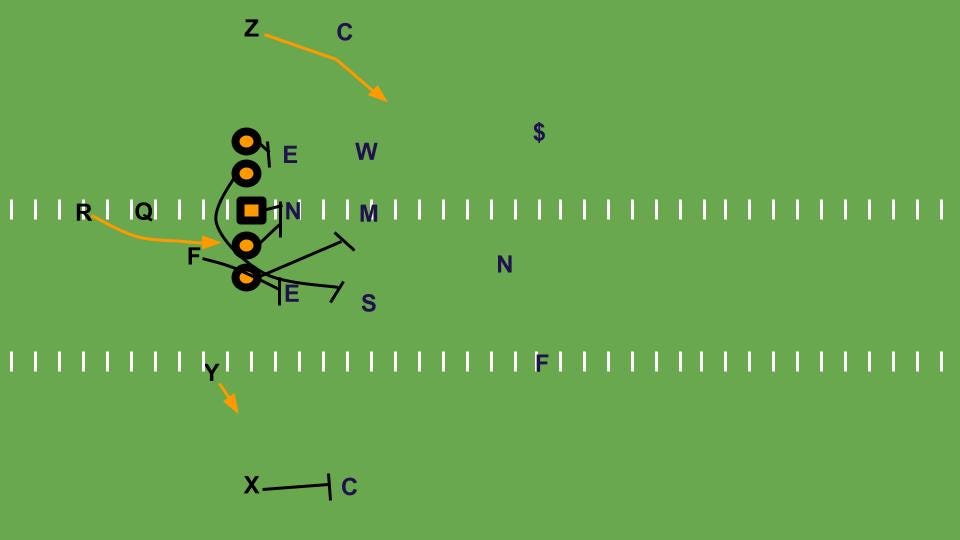
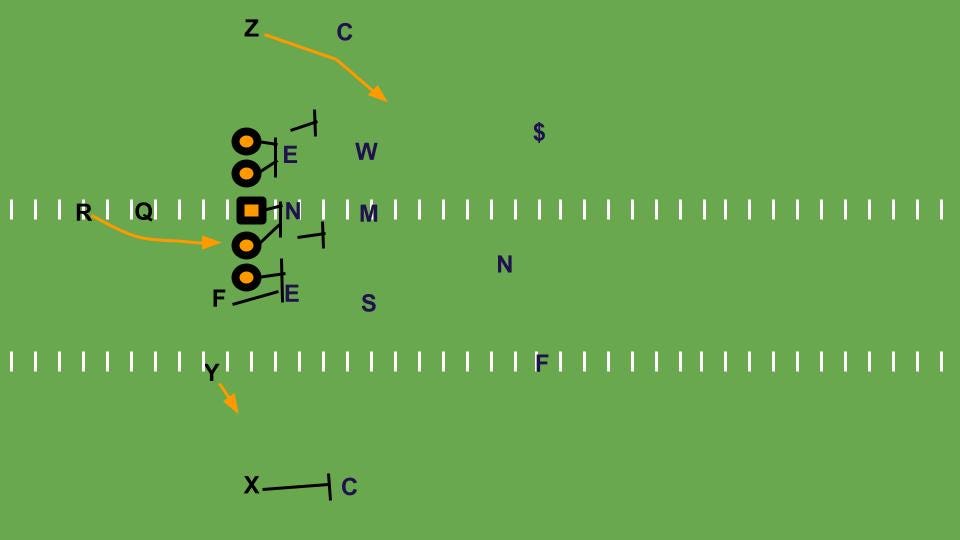

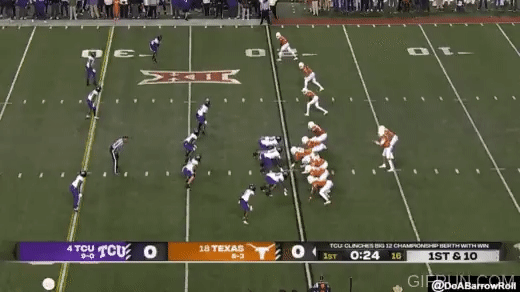
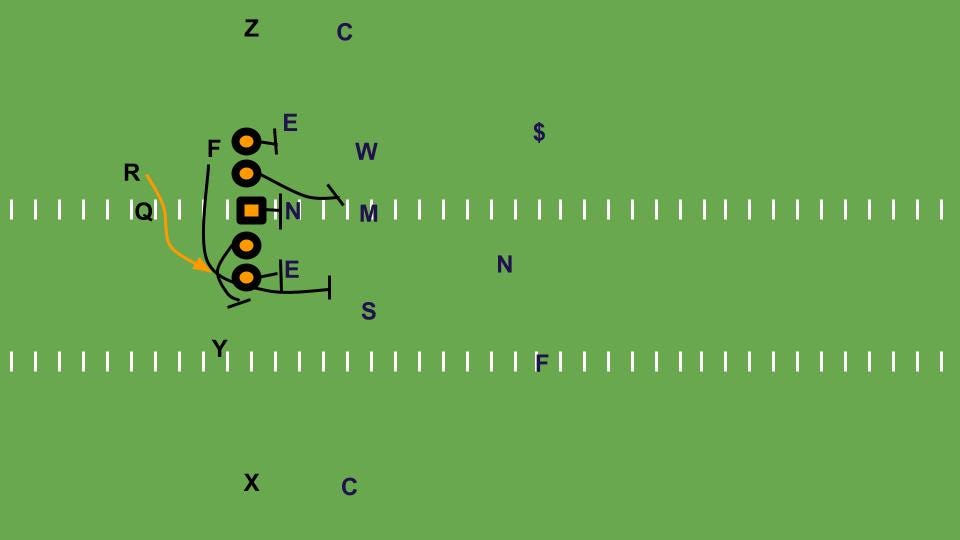
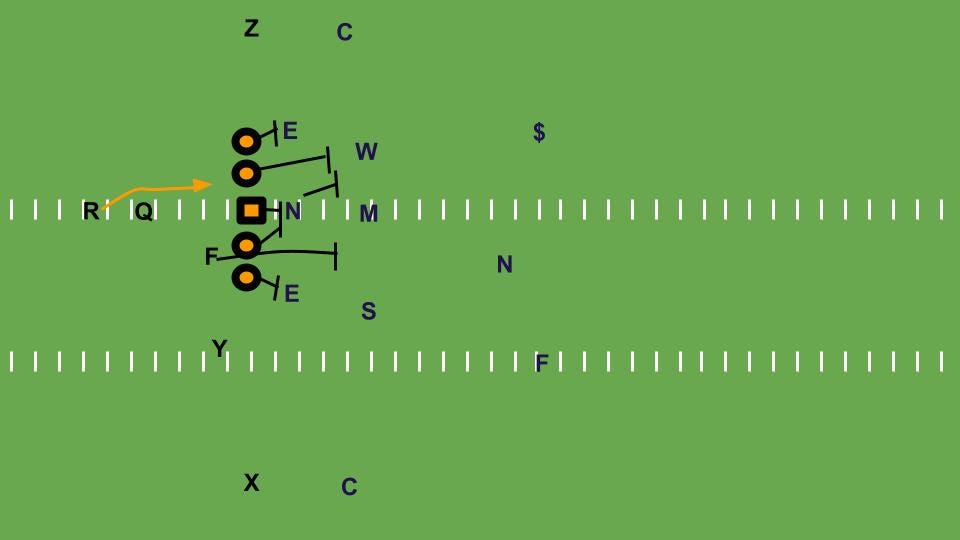
That's why we're here my Longhorn friend. So much better than the screaming forums.
IAN….let me see if I’ve got this right… 1. Be careful to not count Gundy out to quickly….2. Ways to attack the Flyover D are finally starting to surface, the key of which seems to be how you occupy the all important N (middle safety who triggers fast)!